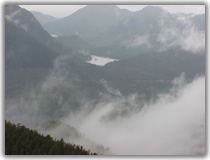Searching for the Needle in a Haystack
By 2Lt Sonia Dumouchel-Connock
PORT HARDY, B.C. - How do you find a small white object in the midst of thousands of miles of water, shoreline and rugged valleys? This is the enormous challenge facing military personnel when tasked with locating and rescuing downed aircraft.
 |
Search and rescue teams often have their work cut out for them searching in rugged, mountainous and difficult terrain. Above, a view from the aircraft shows mist covered mountain air that must be searched for a missing aircraft.
Photo : 2Lt Sonia Dumouchel-Connock
|
"It's like searching for a needle in a haystack," says Captain Dan Stanton, a Cormorant pilot and search and rescue (SAR) searchmaster from 442 Transport and Rescue Squadron, Comox, B.C. "We use all the resources available to try to find aircraft that have gone missing, and we continue to search until we exhaust every possible means of finding the missing pilots and passengers."
When an aircraft fails to arrive at its destination and does not call to announce it will be late, Victoria's Joint Rescue Coordination Centre (JRCC) is alerted. If the aircraft is carrying an emergency locator transmitter (ELT), a device that emits a signal announcing to the rescue centre the position of the downed aircraft, a SAR crew is dispatched to the location of the signal to rescue the distressed aircraft.
If the aircraft is not carrying an ELT, or if the aircraft's ELT is damaged in the crash, the position of the downed aircraft is not known and the detective work begins. Canadian Coast Guard and CF personnel working at JRCC get on the phone with airports along the flight path of the missing aircraft and start putting together a chronology of events. They try to ascertain such things as the condition of the aircraft during the various legs of its journey, the amount of fuel it was carrying, and the types of navigation and emergency equipment embarked. Weather reports are analysed to form a picture of the conditions the missing aircraft may have encountered, and information about the habits, character and experience of the pilot is obtained from friends and family.
 |
A spotter keeps a sharp eye out for any signs of a missing aircraft during a search and rescue mission conducted on Canada's West Coast by members of 442 (T&R) Sqn.
Photo : 442 Sqn |
Every piece of information is a part of a jigsaw puzzle that, when put together, gives rescuers a picture of what might have happened to the missing aircraft. "We try to gather as much information as possible so that we can recreate in our minds what happened to the missing aircraft," says Capt Stanton. "With that information, we can then come up with the best plan of action to rescue the pilots and passengers."
A Buffalo aircraft and Cormorant helicopter, which are on continuous standby at 442 (T&R) Sqn, can be dispatched within an hour to search the flight path of the missing aircraft. As other aircraft become available and join in the search, the search plan becomes more complex. An area 24 km on both sides of the flight path is investigated. A "creeping line ahead" search is made over water-once the aircraft has searched in a straight line in its designated search area, it turns around and examines a line parallel to the first, until the whole of the search area has been covered. In hilly areas where this search pattern is not effective, searchers do a contour search. The aircraft circles around peaks and examines the hill at every elevation.
"Searches are initially made at high altitudes," says Capt Stanton. "Crews look for columns of smoke, signals fires and so on." If the searches do not turn up the missing aircraft, searches are then made at lower altitudes.
To facilitate the search, a search headquarters may be established in an airport close to the search area, and manned by experience SAR aircrew and administrative staff. The headquarters then assumes control of the search from JRCC, and a searchmaster is appointed to co-ordinate the activities of the aircraft engaged in the search.
Search headquarters is a place of bustling activity. Like detectives, the searchmaster and other members of the headquarters, gather information from various sources. The aircrafts conducting the searches call in situation reports every hour; calls are made to various radar and rescue stations to find out whether the missing aircraft may have been spotted or tracked. Sighting reports made by Coast Guard vessels, fishing vessels, pleasure craft and concerned citizens who think they may have seen or heard the missing aircraft are investigated.
As the search develops, the maps on the walls delineating the search area become covered with more and more information. The search area is broken down into sections and assigned to a SAR aircraft for investigation. Areas that have been successfully searched are shaded and the locations of possible sightings are marked with coloured pins.
"Our search and rescue personnel are skilled and experienced," says Capt Stanton. "Throughout a SAR operation, we work tirelessly to find the missing people and we try to remain optimistic about having a positive outcome."
When a missing aircraft is located the best means of reaching the site is determined and rescue and or recovery operations proceed.
2Lt Dumouchel-Connock is the Western Area Air Reserve PAO. |